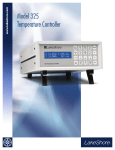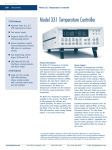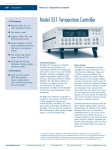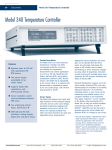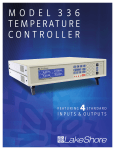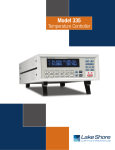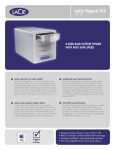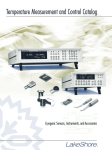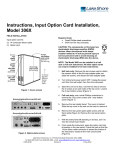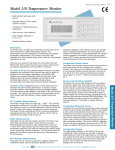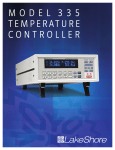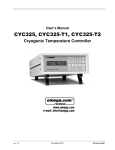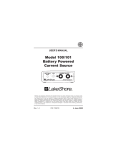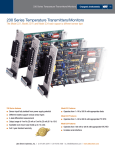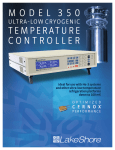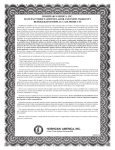Download Model 325 Temperature Controller
Transcript
www.lakeshore.com Model 325 Temperature Controller Operates down to 1.2 K with appropriate sensor Two sensor inputs Model 325 Temperature Controller Supports diode, RTD, and thermocouple sensors Sensor excitation current reversal eliminates thermal EMF errors in resistance sensors Two autotuning control loops: 25 W and 2 W maximum Control loop 2: variable DC voltage source from 0 to 10 V maximum IEEE-488 and RS-232C interfaces Introduction Standard temperature response curves for silicon diodes, platinum RTDs, ruthenium oxide RTDs, and many thermocouples are included. Up to fifteen 200-point CalCurves® (for Lake Shore calibrated temperature sensors) or user curves can be stored into non-volatile memory. A built-in SoftCal®1 algorithm can be used to generate curves for silicon diodes and platinum RTDs for storage as user curves. The Lake Shore curve handler software program allows sensor curves to be easily loaded and manipulated. The Model 325 dual-channel temperature controller is capable of supporting nearly any diode, RTD, or thermocouple temperature sensor. Two independent PID control loops with heater outputs of 25 W and 2 W are configured to drive either a 50 Ω or 25 Ω load for optimal cryocooler control flexibility. Designed with ease of use, functionality, and value in mind, the Model 325 is ideal for general-purpose laboratory and industrial temperature measurement and control applications. Sensor inputs for the Model 325 are factory configured and compatible with either diodes/RTDs or thermocouple sensors. Your choice of two diode/ RTD inputs, one diode/RTD input and one thermocouple input, or two thermocouple inputs must be specified at time of order and cannot be reconfigured in the field. Software selects appropriate excitation current and signal gain levels when the sensor type is entered via the instrument front panel. Sensor Inputs The Model 325 temperature controller features two inputs with a highresolution 24-bit analog-to-digital converter and separate current sources for each input. Constant current excitation allows temperature to be measured and controlled down to 2.0 K using appropriate Cernox™ RTDs or down to 1.4 K using silicon diodes. Thermocouples allow for temperature measurement and control above 1,500 K. Sensors are optically isolated from other instrument functions for quiet and repeatable sensor measurements. The Model 325 also uses current reversal to eliminate thermal EMF errors in resistance sensors. Sensor data from each input is updated up to ten times per second, with display outputs twice each second. 1 The Lake Shore SoftCal™ algorithm for silicon diode and platinum RTD sensors is a good solution for applications requiring more accuracy than a standard sensor curve but not in need of traditional calibration. SoftCal uses the predictability of a standard curve to improve the accuracy of an individual sensor around a few known temperature reference points. 2 www.lakeshore.com Lake Shore Cryotronics, Inc. (614) 891-2244 fax: (614) 818-1600 e-mail: [email protected] Temperature Control Interface The Model 325 temperature controller offers two independent proportionalintegral-derivative (PID) control loops. A PID algorithm calculates control output based on temperature setpoint and feedback from the control sensor. Wide tuning parameters accommodate most cryogenic cooling systems and many small high-temperature ovens. A highresolution digital-to-analog converter generates a smooth control output. The user can set the PID values or the Autotuning feature of the Model 325 can automate the tuning process. The Model 325 includes both parallel (IEEE-488) and serial (RS-232C) computer interfaces. In addition to data gathering, nearly every function of the instrument can be controlled via computer interface. Sensor curves can also be entered and manipulated through either interface using the Lake Shore curve handler software program. Control loop 1 heater output for the Model 325 is a well-regulated variable DC current source. The output can provide up to 25 W of continuous power to a 50 Ω or 25 Ω heater load, and includes a lower range for systems with less cooling power. Control loop 2 heater output is a single-range, variable DC voltage source. The output can source up to 0.2 A, providing 2 W of heater power at the 50 Ω setting or 1 W at the 25 Ω setting. When not being used for temperature control, the loop 2 heater output can be used as a manually controlled voltage source. The output voltage can vary from 0 to 10 V on the 50 Ω setting, or 0 to 5 V on the 25 Ω setting. Both heater outputs are referenced to chassis ground. The setpoint ramp feature allows smooth continuous setpoint changes and can also make the approach to setpoint more predictable. The zone feature can automatically change control parameter values for operation over a large temperature range. Ten different temperature zones can be loaded into the instrument, which will select the next appropriate value on setpoint change. Normal (Default) Display Configuration The display provides four reading locations. Readings from each input and the control setpoint can be expressed in any combination of temperature or sensor units, with heater output expressed as a percent of full scale current or power. Configurable Display The Model 325 offers a bright, easy to read LCD display that simultaneously displays up to four readings. Display data includes input and source annunciators for each reading. All four display locations can be configured by the user. Data from either input can be assigned to any of the four locations, and the user’s choice of temperature or sensor units can be displayed. Heater range and control output as current or power can be continuously displayed for immediate feedback on control operation. The channel A or B indicator is underlined to indicate which channel is being controlled by the displayed control loop. Flexible Configuration Reading locations can be configured by the user to meet application needs. The character preceding the reading indicates input A or B or setpoint S. The character following the reading indicates measurement units. Curve Entry The Model 325 display offers the flexibility to support curve, SoftCal™, and zone entry. Curve entry may be performed accurately and to full resolution via the display and keypad as well as computer interface. Model 325 Rear Panel Connections Loop 1 Heater Output Serial (RS-232C) I/O (DTE) Line Input Assembly Loop 2 Heater Output Sensor Input Connectors IEEE-488 Interface 3 www.lakeshore.com Lake Shore Cryotronics, Inc. (614) 891-2244 fax: (614) 818-1600 e-mail: [email protected] Sensor Selection Sensor Temperature Range (sensors sold separately) Diodes Silicon Diode Silicon Diode Silicon Diode Silicon Diode Silicon Diode Silicon Diode GaAlAs Diode GaAlAs Diode GaAlAs Diode Positive Temperature Coefficient RTDs 100 Ω Platinum 100 Ω Platinum Rhodium-Iron Rhodium-Iron Negative Temperature Coefficient RTDs2 Cernox™ Cernox™ Cernox™ Cernox™ Cernox™ Germanium Germanium Germanium Carbon-Glass Carbon-Glass Carbon-Glass Rox™ Thermocouples Type K Type E ChromelAuFe 0.07% Model Useful Range Magnetic Field Use DT-670-SD DT-670E-BR DT-414 DT-421 DT-470-SD DT-471-SD TG-120-P TG-120-PL TG-120-SD 1.4 K to 500 K 30 K to 500 K 1.4 K to 375 K 1.4 K to 325 K 1.4 K to 500 K 10 K to 500 K 1.4 K to 325 K 1.4 K to 325 K 1.4 K to 500 K T ≥ 60 K & B ≤ 3 T T ≥ 60 K & B ≤ 3 T T ≥ 60 K & B ≤ 3 T T ≥ 60 K & B ≤ 3 T T ≥ 60 K & B ≤ 3 T T ≥ 60 K & B ≤ 3 T T > 4.2 K & B ≤ 5 T T > 4.2 K & B ≤ 5 T T > 4.2 K & B ≤ 5 T PT-102/3 PT-111 RF-800-4 RF-100T/U 14 K to 873 K 14 K to 673 K 1.4 K to 500 K 1.4 K to 325 K T > 40 K & B ≤ 2.5 T T > 40 K & B ≤ 2.5 T T > 77 K & B ≤ 8 T T > 77 K & B ≤ 8 T CX-1010 CX-1030-HT CX-1050-HT CX-1070-HT CX-1080-HT GR-200A/B-1000 GR-200A/B-1500 GR-200A/B-2500 CGR-1-500 CGR-1-1000 CGR-1-2000 RX-102A 2 K to 325 K5 3.5 K to 420 K3, 6 4 K to 420 K3, 6 15 K to 420 K3 50 K to 420 K3 2.2 K to 100 K4 2.6 K to 100 K4 3.1 K to 100 K4 4 K to 325 K5 5 K to 325 K5 6 K to 325 K5 1.4 K to 40 K5 T > 2 K & B ≤ 19 T T > 2 K & B ≤ 19 T T > 2 K & B ≤ 19 T T > 2 K & B ≤ 19 T T > 2 K & B ≤ 19 T Not Recommended Not Recommended Not Recommended T > 2 K & B ≤ 19 T T > 2 K & B ≤ 19 T T > 2 K & B ≤ 19 T T > 2 K & B ≤ 10 T 9006-006 9006-004 3.2 K to 1505 K 3.2 K to 934 K Not Recommended Not Recommended 9006-002 1.2 K to 610 K Not Recommended Silicon diodes are the best choice for general cryogenic use from 1.4 K to above room temperature. Diodes are economical to use because they follow a standard curve and are interchangeable in many applications. They are not suitable for use in ionizing radiation or magnetic fields. Cernox™ thin-film RTDs offer high sensitivity and low magnetic field-induced errors over the 2 K to 420 K temperature range. Cernox sensors require calibration. Platinum RTDs offer high uniform sensitivity from 30 K to over 800 K. With excellent reproducibility, they are useful as thermometry standards. They follow a standard curve above 70 K and are interchangeable in many applications. Single excitation current may limit the low temperature range of NTC resistors Non-HT version maximum temperature: 325 K 4 Low temperature limited by input resistance range 5 Low temperature specified with self-heating error: ≤5 mK 6 Low temperature specified with self-heating error: ≤12 mK 2 3 4 www.lakeshore.com Lake Shore Cryotronics, Inc. (614) 891-2244 fax: (614) 818-1600 e-mail: [email protected] Typical Sensor Performance – see Appendix F for sample calculations of typical sensor performance Silicon Diode Silicon Diode GaAlAs Diode 100 Ω Platinum RTD 500 Ω Full Scale Cernox™ Germanium Carbon-Glass Thermocouple 50 mV Example Lake Shore Sensor Temp Nominal Resistance/ Voltage Typical Sensor Sensitivity7 Measurement Resolution: Temperature Equivalents Electronic Accuracy: Temperature Equivalents Temperature Accuracy including Electronic Accuracy, CalCurve™, and Calibrated Sensor DT-670-SD-13 with 1.4H calibration 1.4 K 1.644 V -12.49 mV/K 0.8 mK ±13 mK ±25 mK ±1.6 mK 77 K 1.028 V -1.73 mV/K 5.8 mK ±76 mK ±98 mK ±11.6 mK 300 K 0.5597 V -2.3 mV/K 4.4 mK ±47 mK ±79 mK ±8.8 mK 500 K 0.0907 V -2.12 mV/K 4.8 mK ±40 mK ±90 mK ±9.6 mK DT-470-SD-13 1.4 K 1.6981 V -13.1 mV/K 0.8 mK ±13 mK ±25 mK ±1.6 mK with 1.4H 77 K 1.0203 V -1.92 mV/K 5.2 mK ±69 mK ±91 mK ±10.4 mK calibration 300 K 0.5189 V -2.4 mV/K 4.2 mK ±45 mK ±77 mK ±8.4 mK 475 K 0.0906 V -2.22 mV/K 4.6 mK ±39 mK ±89 mK ±9.2 mK TG-120-SD 1.4 K 5.391 V -97.5 mV/K 0.2 mK ±7 mK ±19 mK ±0.4 mK with 1.4H 77 K 1.422 V -1.24 mV/K 16.2 mK ±180 mK ±202 mK ±32.4 mK calibration 300 K 0.8978 V -2.85 mV/K 7 mK ±60 mK ±92 mK ±14 mK 475 K 0.3778 V -3.15 mV/K 6.4 mK ±38 mK ±88 mK ±12.8 mK 30 K 3.660 Ω 0.191 Ω/K 10.5 mK ±23 mK ±33 mK ±21 mK PT-103 Electronic Control Stability8: Temperature Equivalents with 1.4J 77 K 20.38 Ω 0.423 Ω/K 4.8 mK ±15 mK ±27 mK ±9.6 mK calibration 300 K 110.35 Ω 0.387 Ω/K 5.2 mK ±39 mK ±62 mK ±10.4 mK 500 K 185.668 Ω 0.378 Ω/K 5.3 mK ±60 mK ±106 mK ±10.6 mK 4.2 K 3507.2 Ω -1120.8 Ω/K 36 µK ±1.4 mK ±6.4 mK ±72 µK with 4M 77 K 205.67 Ω -2.4116 Ω/K 16.6 mK ±76 mK ±92 mK ±33.2 mK calibration 300 K 59.467 Ω -0.1727 Ω/K 232 mK ±717 mK ±757 mK ±464 mK 420 K 45.030 Ω -0.0829 Ω/K 483 mK ±1.42 K ±1.49 K ±966 mK GR-200A-1000 2K 6674 Ω -9930 Ω/K 4 µK ±0.3 mK ±4.3 mK ±8 µK with 1.4D 4.2 K 1054 Ω -526 Ω/K 76 µK ±1 mK ±5 mK ±152 µK calibration 10 K 170.9 Ω -38.4 Ω/K 1 mK ±4.4 mK ±9.4 mK ±2 mK 100 K 2.257 Ω -0.018 Ω/K 2.22 K ±5.61 K ±5.626 K ±4.44 K 4.2 K 2260 Ω -2060 Ω/K 20 µK ±0.5 mK ±4.5 mK ±40 µK CX-1050-SD-HT9 CGR-1-2000 with 4L 77 K 21.65 Ω -0.157 Ω/K 255 mK ±692 mK ±717 mK ±510 mK calibration 300 K 11.99 Ω -0.015 Ω/K 2.667 K ±7 K ±7.1 K ±5.334 K Type K 75 K -5862.9 µV 15.6 µV/K 26 mK ±0.25 K10 Calibration not available ±52 mK 300 K 1075.3 µV 40.6 µV/K 10 mK ±0.038 K10 from Lake Shore ±20 mK 600 K 13325 µV 41.7 µV/K 10 mK ±0.184 K ±20 mK 1505 K 49998.3 µV 36.006 µV/K 12 mK ±0.73 K10 ±24 mK 10 Typical sensor sensitivities were taken from representative calibrations for the sensor listed Control stability of the electronics only, in an ideal thermal system 9 Non-HT version maximum temperature: 325 K 10 Accuracy specification does not include errors from room temperature compensation 7 8 5 www.lakeshore.com Lake Shore Cryotronics, Inc. (614) 891-2244 fax: (614) 818-1600 e-mail: [email protected] Model 325 Specifications Input Specifications Sensor Temperature Coefficient Input Range Excitation Current Display Resolution Measurement Resolution Electronic Accuracy Electronic Control Stability11 negative 0 V to 2.5 V 10 µA ±0.05%12, 13 100 µV 10 µV ±80 µV ±0.005% of rdg ±20 µV negative 0 V to 7.5 V 10 µA ±0.05%12, 13 100 µV 20 µV ±80 µV ±0.01% of rdg ±40 µV positive 0 Ω to 500 Ω 1 mA 10 mΩ 2 mΩ ±0.004 Ω ±0.01% of rdg ±4 mΩ positive 0 Ω to 5000 Ω 1 mA14 100 mΩ 20 mΩ ±0.04 Ω ±0.02% of rdg ±40 mΩ NTC RTD negative 0 Ω to 7500 Ω 10 µA ±0.05%14 100 mΩ 40 mΩ ±0.1 Ω ±0.04% of rdg ±80 mΩ Thermocouple positive ±25 mV NA 1 µV 0.4 µV ±1 µV ±0.05% of rdg15 ±0.8 µV positive ±50 mV NA 1 µV 0.4 µV ±1 µV ±0.05% of rdg ±0.8 µV Diode PTC RTD 14 11 14 12 15 Control stability of the electronics only, in an ideal thermal system Current source error has negligible effect on measurement accuracy 13 Diode input excitation current can be set to 1 mA – refer to the Model 325 user manual for details Thermometry Number of inputs Input configuration 2 Each input is factory configured for either diode/RTD or thermocouple Isolation Sensor inputs optically isolated from other circuits but not each other A/D resolution 24-bit Input accuracy Sensor dependent – refer to Input Specifications table Measurement resolution Sensor dependent – refer to Input Specifications table Maximum update rate 10 rdg/s on each input (except 5 rdg/s on input A when configured as thermocouple) User curves Room for 15 200-point CalCurves™ or user curves SoftCal™ Improves accuracy of DT-470 diode to ±0.25 K from 30 K to 375 K; improves accuracy of platinum RTDs to ±0.25 K from 70 K to 325 K; stored as user curves Filter Averages 2 to 64 input readings Control Current source error is removed during calibration Accuracy specification does not include errors from room temperature compensation Control loops Control type Tuning Control stability PID control settings Proportional (gain) Integral (reset) Derivative (rate) Manual output Zone control Setpoint ramping Safety limits 15 2 Closed loop digital PID with manual heater output or open loop Autotune (one loop at a time), PID, PID zones Sensor dependent – see Input Specification table 0 to 1000 with 0.1 setting resolution 1 to 1000 (1000/s) with 0.1 setting resolution 1 to 200% with 1% resolution 0 to 100% with 0.01% setting resolution 10 temperature zones with P, I, D, manual heater out, and heater range 0.1 K/min to 100 K/min Curve temperature, power up heater off, short circuit protection Sensor Input Configuration Diode/RTD Thermocouple 4-lead differential 2-lead, room temperature compensated Constant current with current reversal for RTDs NA Supported sensors Diodes: Silicon, GaAlAs RTDs: 100 Ω Platinum, 1000 Ω Platinum, Germanium, Carbon-Glass, Cernox™, and Rox™ Most thermocouple types Standard curves DT-470, DT-500D, DT-670, PT-100, PT-1000, RX-102A, RX-202A Type E, Type K, Type T, AuFe 0.07% vs. Cr, AuFe 0.03% vs. Cr Input connector 6-pin DIN Ceramic isothermal block Measurement type Excitation 6 www.lakeshore.com Lake Shore Cryotronics, Inc. (614) 891-2244 fax: (614) 818-1600 e-mail: [email protected] Loop 1 Heater Output Type D/A resolution Max power Max current Voltage compliance (min) Heater load range Heater load for max power Ranges Heater noise (<1 kHz) Grounding Heater connector Loop 2 Heater Output 25 Ω Setting 50 Ω Setting Variable DC current source 16-bit 25 W 1A 0.71 A 25 V 35.4 V 40 Ω to 50 Ω 20 Ω to 25 Ω 25 Ω 50 Ω 2 (2.5 W/25 W) 1 µA + 0.01% of output Output referenced to chassis ground Dual banana Front Panel Display 2-line × 20-character, liquid crystal display with 5.5 mm character height Number of reading displays 1 to 4 Display units K, °C, V, mV, Ω Reading source Temperature, sensor units Display update rate 2 rdg/s Temp display resolution 0.001° from 0° to 99.999°, 0.01° from 100° to 999.99°, 0.1° above 1000° Sensor units display resolution Sensor dependent; to 5 digits Other displays Setpoint, Heater Range, and Heater Output (user selected) Setpoint setting resolution Same as display resolution (actual resolution is sensor dependent) Heater output display Numeric display in percent of full scale for power or current Heater output resolution 1% Display annunciators Control Input, Remote, Autotune Keypad 20-key membrane, numeric and specific functions Front panel features Front panel curve entry, keypad lock-out Interface IEEE-488 interface Features Reading rate Software support Serial interface Electrical format Baud rates Connector Reading rate General SH1, AH1, T5, L4, SR1, RL1, PP0, DC1, DT0, C0, E1 To 10 rdg/s on each input LabVIEW™ driver (consult factory for availability) RS-232C 9600, 19200, 38400, 57600 9-pin D-style, DTE configuration To 10 rdg/s on each input Ambient temperature 15 °C to 35 °C at rated accuracy, 5 °C to 40 °C at reduced accuracy Power requirement 100, 120, 220, 240 VAC, +6%, -10%, 50 or 60 Hz, 85 VA Size 216 mm W × 89 mm H × 368 mm D (8.5 in × 3.5 in × 14.5 in), half rack Weight 4.00 kg (8.82 lb) Approval CE mark Type D/A resolution Max power Max voltage Current compliance (min) Heater load range Heater load for max power Ranges Heater noise (<1 kHz) Grounding Heater connector 25 Ω Setting 50 Ω Setting Variable DC voltage source 16-bit 1W 2W 5V 10 V 0.2 A ≥ 25 Ω ≥ 50 Ω 25 Ω 50 Ω 1 50 µV + 0.01% of output Output referenced to chassis ground Detachable terminal block Ordering Information Part number Description 325 325-T1 325-T2 Two diode/RTD inputs One diode/RTD, one thermocouple input Two thermocouple inputs Specify line power option* VAC-100 Instrument configured for 100 VAC with U.S. power cord VAC-120 Instrument configured for 120 VAC with U.S. power cord VAC-120-ALL Instrument configured for 120 VAC with U.S. power cord and universal Euro line cord and fuses for 220/240 VAC setting VAC-220 Instrument configured for 220 VAC with universal Euro line cord VAC-240 Instrument configured for 240 VAC with universal Euro line cord *Other country line cords available, consult Lake Shore Accessories included 106-009 106-233 106-735 —— MAN-325 Heater output connector (dual banana jack) Sensor input mating connector (6-pin DIN plugs) Terminal block, 2-pin Calibration certificate Model 325 user manual Accessories available 6201 1 m (3.3 ft long) IEEE-488 (GPIB) computer interface cable assembly 8001-325 CalCurve™, factory installed – the breakpoint table from a calibrated sensor stored in the instrument (extra charge for additional sensor curves) CAL-325-CERT Instrument recalibration with certificate CAL-325-DATA Instrument recalibration with certificate and data RM-½ Kit for mounting one ½ rack temperature controller in a 482.6 mm (19 in) rack, 90 mm (3.5 in) high RM-2 Kit for mounting two ½ rack temperature controllers in a 482.6 mm (19 in) rack, 135 mm (5.25 in) high All specifications are subject to change without notice 7 www.lakeshore.com Lake Shore Cryotronics, Inc. (614) 891-2244 fax: (614) 818-1600 e-mail: [email protected] Lake Shore Cryotronics, Inc. 575 McCorkle Boulevard Westerville, OH 43082-8888 USA Tel 614-891-2244 Fax 614-818-1600 e-mail [email protected] www.lakeshore.com Established in 1968, Lake Shore Cryotronics, Inc. is an international leader in developing innovative measurement and control solutions. Founded by Dr. John M. Swartz, a former professor of electrical engineering at the Ohio State University, and his brother David, Lake Shore produces equipment for the measurement of cryogenic temperatures, magnetic fields, and the characterization of the physical proper ties of materials in temperature and magnetic environments.








